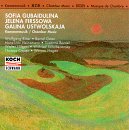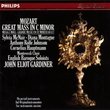| All Artists: Gubaidulina, Firssowa, Ustwolskaja Title: Gubaydulina, Firsowa and Ustwolskaya: Chamber Music by Russian Women Members Wishing: 0 Total Copies: 0 Label: Koch Schwann (Germ.) Release Date: 3/21/1995 Album Type: Import Genre: Classical Style: Chamber Music Number of Discs: 1 SwapaCD Credits: 1 UPC: 099923117025 |
Search - Gubaidulina, Firssowa, Ustwolskaja :: Gubaydulina, Firsowa and Ustwolskaya: Chamber Music by Russian Women
 | Gubaidulina, Firssowa, Ustwolskaja Gubaydulina, Firsowa and Ustwolskaya: Chamber Music by Russian Women Genre: Classical
|
Larger Image |
CD DetailsSimilar CDs
|
CD ReviewsTwo lesser-known but enjoyable Gubaidulina pieces Christopher Culver | 02/24/2010 (3 out of 5 stars) "This old Koch Swann disc contains pieces by three female composers who came of age in the Soviet Union: Sofia Gubaidulina, Elena Firsova and Galina Ustvolskaya. I'm mainly a fan of Gubaidulina and encountered this disc while expanding my collection of her works, so I'll limit my review to her two pieces here.
The pairing of these two Gubaidulina pieces is interesting, as they are less than a decade apart and yet show an enormous progression. The Quartet for 4 Flutes (1977) is scored mainly for four soprano flutes, but three players change at times to alto flute. This is essentially a study in how to differentiate four instruments of identical timbre, and Gubaidulina does succeed in this fairly well. The first two movements are a somewhat uninspired development of a pentatonic theme. In the remaining three movements, however, one can find in embryonic form Gubaidulina's later soundworld with. For example, one flute maintains an anguished ascending melody as the other flutes produce an aleatoric cloud of sound. This is, as far as I know, the only recording of this piece around. True, this disc is long out of print, but Koch recordings tend to wind up being reissued elsewhere, so there's hope that this piece will again be widely accessible. "Quasi Hoquetus" for viola, bassoon and piano (1984, rev. 1985) was written after Gubaidulina had entered into numerical mysticism, structuring her pieces with the Fibonacci sequence. This mathematical principle, she thought, gave the music form but nonetheless allowed it to "breathe". It's essentially a rondo in seven sections (another magic number), where each of the parts interlocks due to specially placed rests or notes, the medieval technique of "hocketing", hence the title. The crystalline nature of the piece reminds one of Webern, one of Gubaiduina's heroes, but the zahlenmystik and spiritually charged use of silence could only come from the Russian Orthodox Gubaidulina. "Quasi hoquetus" is a piece of great complexity but with very elegant proportions. Fans of the composer's masterpiece symphony "Stimmen... Verstummen..." will find many similarities in this chamber work. The performers here are Thomas Oepen (viola), Wilfried Schoberansky (bassoon) and Werner Hagen (piano). It is competent, but I prefer the recording on a Chandos disc by dedicatees of the piece: Valery Popov, the composer's favourite bassoonist, as well as pianist Bakhchiyev." |

 Track Listings (14) - Disc #1
Track Listings (14) - Disc #1


